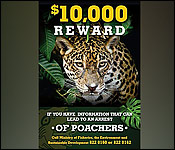
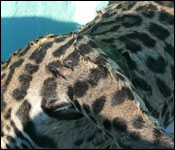 Tonight, there is a ten thousand dollar reward being offered for any information that can lead to the arrest of poachers responsible for the carcasses of two juvenile jaguars found floating in the Belize district river and drainage systems.
Tonight, there is a ten thousand dollar reward being offered for any information that can lead to the arrest of poachers responsible for the carcasses of two juvenile jaguars found floating in the Belize district river and drainage systems.
One of them was decapitated, the other died of causes unknown. Considering the endangered status of this animal, its role to the ecosystem, and the sheer majesty of these apex predators - it really is an awful, ugly tragedy.
In 2008, we found out much more about the movements and hunting patterns of this celebrated cat when we went with Dr. Omar Figueroa into the Belize Central Corridor on a tracking and trapping mission. Here's our story from 9 and a half years ago:
Jules Vasquez Reporting
This is the Runaway Creek Nature Reserve. In the early light it seems picturesque as the morning sun shimmers and dances on a wet weather pond. But don't let that idyllic setting fool you, this place can be hell! First there's the nearly impassable roads...and while those are difficult, the bush is far worse.
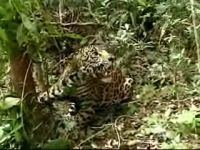
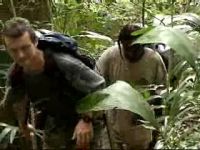 This may look like a casual jungle hike led by Reserve Manager Reynold Cal with jaguar experts Omar Figueroa and Bart Harmsen and Pecarry Hills guide Gilford Hoare. But after the floods, it feels like a descent into hell: it's a trek through the most mosquito infested area I've ever encountered. And if you don't see a cloud of them hovering behind Figueroa's backpack you can see them here, when he stops. But what to do? Just shake them off and walk on - on the trail of the jaguar.
This may look like a casual jungle hike led by Reserve Manager Reynold Cal with jaguar experts Omar Figueroa and Bart Harmsen and Pecarry Hills guide Gilford Hoare. But after the floods, it feels like a descent into hell: it's a trek through the most mosquito infested area I've ever encountered. And if you don't see a cloud of them hovering behind Figueroa's backpack you can see them here, when he stops. But what to do? Just shake them off and walk on - on the trail of the jaguar.
Omar Figueroa, Jaguar Researcher
"We're trapping jaguars and pumas and deploying GPS collars with a pre-determined program of positioning fixes."
Figueroa knows that the cats are frequent visitors to this cave and they have been captured on specialised unmanned photosensitive cameras that were placed in the cave and all along this route to make sure they are looking in the right place. And the cave is one of those places where the big cats bring prey to eat, away from the mosquitoes and the heat. Cat scat as it's called shows that they've been through here fairly recently. These shards of pottery indicate that the cave was also used plentifully by the Mayas along with jaguars. One of them crushed this turtle and this armadillo.
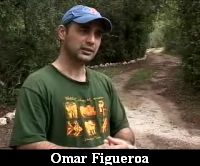 Omar Figueroa
Omar Figueroa
"They usually attack by grabbing an animal by the back of the neck. They bite and then they break their skulls here at the back."
But after a brief stop in the cave, it's more trekking, deeper into the jungle where after an hour we do find a spider monkey who looks like he's having his own mosquito issues but no jaguar as the trap we've come to check is unsprung.
Reynold Cal
"So it is negative for today but tomorrow's another day."
He's re-covering the neatly concealed trap - so that the jaguar doesn't see it. This is the first time this type of leg hold trap has been used in Central America.
Omar Figueroa
"It's a leg hold trap, a specialized leg hold trap that essentially tightens a noose around the jaguar's leg. It comes equipped with a shabsorber so that when the jaguar jerks on it, the joints are not injured and it also has swivels so there is no twisting on the leg. So it is by far the safest method to trap these large carnivores."
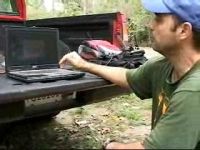
 And to demonstrate how safe, Figueroa tested it himself - showing that it caused no trauma to his hand. But apart from being harmless and almost undetectable on the jungle floor, the trap's most important feature is that it is fitted with a radio transmitter, which tells the trapper when something's been caught. When it is activated this pin is released and it sends a signal to trappers out in the field who use this portable antenna to track the radio signal. One beep every three seconds like this.
And to demonstrate how safe, Figueroa tested it himself - showing that it caused no trauma to his hand. But apart from being harmless and almost undetectable on the jungle floor, the trap's most important feature is that it is fitted with a radio transmitter, which tells the trapper when something's been caught. When it is activated this pin is released and it sends a signal to trappers out in the field who use this portable antenna to track the radio signal. One beep every three seconds like this.
[Beeping...this is 07 and then that one is not triggered and then 08...beeping...one pulse every three seconds.]
Means nothing has been captured; if it beeped three times a second that would have meant something was caught. Nothing on this day but weeks earlier the beeps came in a flurry, and this snarling jaguar was waiting for them.
Coming in direct physical contact with a wild jaguar is a rare and exhilarating moment that very few have had.
Omar Figueroa
"You have to understand that we're dealing here with the largest cat in the Americas and, if you really look at it real closely, we're looking at the cat that has the strongest bite, pound for pound in terms of pressure per square inch; the strongest bite of any of the large cats all over this planet."
Bart Harmsen has been working with jaguar research in the Cocksomb for five years but he's never been this close.
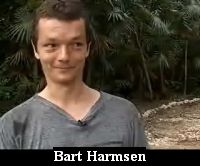 Bart Harmsen
Bart Harmsen
"Suddenly you can touch your study animal and for me that was one of the most thrilling moments in the world in a lot of ways. Before that it's been four years of seeing sometimes maybe a glimpse of them or seeing them sometimes walking on the trail and suddenly you have this powerful cat right in front of you and it is a magical feeling. I feel like a privileged person now that I can do that."
Omar Figueroa
"So it is intimidating and you have to be very careful. When I encounter a cat in a trap, I really don't have time to think about a lot of things. I get focused and I just have to make sure I drug that cat as quickly as possible because the jaguar is coming at you. The difference between a jaguar and a puma in a trap is the puma is running away from you and the jaguar is coming at you. So you have to move fast and there is no room for error."
"This is what he moves with, a carbon powered tranquilizer gun, seen here under the tutelage of world re-knowned trapping expert Barren Simpson. Here, this puma gathers a defensive stance but is hit before he knows what caught him and shortly after he's falling asleep."
Bart Harmsen
"We need to know how these cats are moving around in this landscape and with this kind of knowledge, knowing how these cats are moving around, the Belize government will be able to shape policy of how they have to deal with these jaguars."
And as what are called apex predators, jaguars are critical to understanding the state of play of the surrounding environment.
Omar Figueroa
"The main reason behind using these cats is that as the apex predator they play a critical role in maintaining the structure and function of ecosystems."
And while tracking will fine tune plans, it will also tell us about this fascinating predator.
Omar Figueroa
"All the large cats Jules, across this planet, have really inspired their fair share of legends of superstitions but only the jaguar has really dominated the culture and the religion of an entire continent. You could go back to as early as recorded history in South America and 5,000 year old jaguar sculptures have been unearthed from that era. You can go back 2000 years ago and there are 20 jaguar sculptures and even around us there are the Mayan times. So from a cultural perspective it is important. It is easy to reach out to people and project the jaguar as the conservation icon."
And a large part of that iconography is the enduring mystery of these predators and their deadly stealth as they traverse the country's interior. And hopefully, some of the allure of that mystery is preserved, even as these cats are studied and probed.
While he was just a field scientist back then Dr. Figueroa is now the Minister of State in the Ministry of Agriculture, Fisheries, Forestry, the Environment, Sustainable Development & Climate Change.
And now, his ministry is offering a ten thousand dollar reward for any information that can lead to the arrest of poachers responsible for those two juvenile jaguars found floating in the Belize district river and drainage systems.
| 
